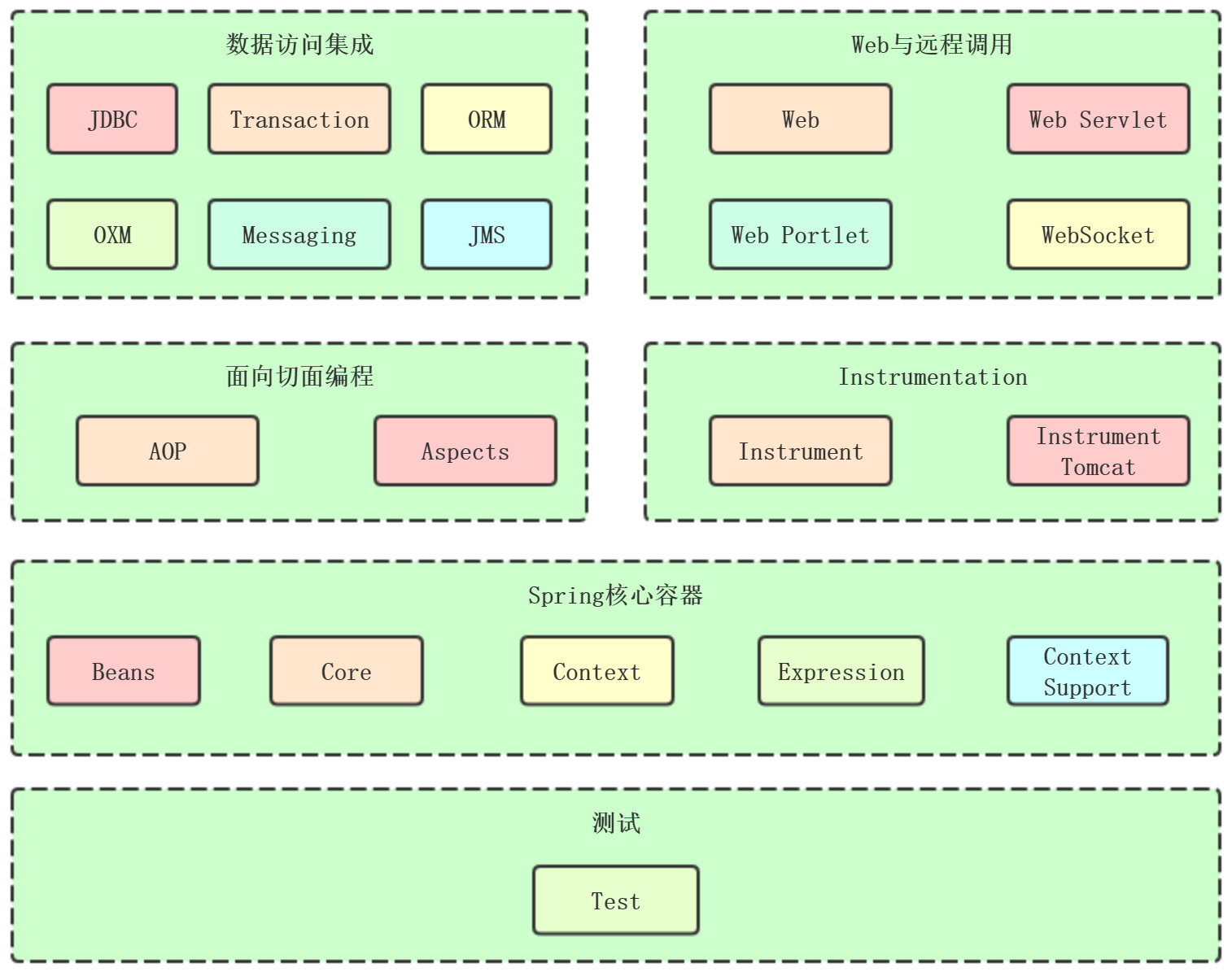Spring框架系列(二)--装配和注入Bean
企业日常开发中,几乎都是Spring系的框架,无论是SSM、还是现在大火的SpringBoot,使用最大的目的就是简化开发
基本模块:

核心容器:Beans、Core、Context、SpEL
1. core和beans模块提供了整个框架最基础的部分,包括了IoC(控制反转)和Dependency Injection(依赖注入)。
2. Context建立在Core和Beans模块提供的基础之上:他提供了框架式访问对象的方式
3. core、beans、context构成了Spring的骨架
4. SpEL:提供了一种强大的用于在运行时操作对象的表达式语言
优点:
1、对象之间的依赖关系通过IOC容器进行管理,降低组件之间的耦合,不需要总是new一个对象
2、提供面向切面编程
3、功能丰富,Transaction、JDBC、WebSocket等
4、轻量级:大小和开销方面都是轻量级的
5、开放性很高,可以选择自己想要使用的功能
装配Bean
pojo的使用体现了非侵入式编程,通过DI进行装配
装配方式:
1、xml显式配置
2、java中显式配置
3、隐式的bean发现机制和自动装配
StudentDaoImpl.java
public class StudentDaoImpl implements StudentDao {
@Override
public void add() {
System.out.println("add");
}
@Override
public void del() {
System.out.println("del");
}
}
StudentServiceImpl.java
@Data
@AllArgsConstructor
public class StudentServiceImpl implements StudentService { private StudentRepository studentResponstory; @Override
public void add() {
System.out.println("add");
} @Override
public void del() {
System.out.println("del");
}
}
1、xml显式配置
Spring最开始的配置方式,相比注解装配和java配置比较麻烦
<?xml version="1.0" encoding="UTF-8"?>
<beans
xmlns="http://www.springframework.org/schema/beans"
xmlns:xsi="http://www.w3.org/2001/XMLSchema-instance"
xmlns:context="http://www.springframework.org/schema/context"
xsi:schemaLocation="http://www.springframework.org/schema/beans http://www.springframework.org/schema/beans/spring-beans.xsd
http://www.springframework.org/schema/context http://www.springframework.org/schema/context/spring-context.xsd"> <beans>
<bean id="studentDao" class="com.it.dao.impl.StudentDaoImpl"/>
<bean id="studentService" class="com.it.service.impl.StudentServiceImpl" >
<constructor-arg ref="studentDao" />
</bean>
</beans> </beans>
xml文件中首先要声明多个xml模式文件,这些xsd文件了配置spring xml元素
通过<bean>去配置,id如果省略的话,自动生成名称:"class内容"#0,可读性较差,一般主动声明,首字母要小写
2、自动化装配Bean
实现:
1、自动扫描@ComponentScan,自动发现应用上下文中所创建的 bean
2、自动装配@Autowired,自动满足 bean 之间的依赖
例如上面例子service和dao之间关系,dao上面都要通过@Component("StudentDao")声明是个组件,通过config的@ComponentScan去扫描(也可以
在xml配置扫描),通过@Autowired去自动注入
@Service
public class StudentServiceImpl implements StudentService { private StudentDao studentDao; @Override
public void add() {
studentDao.add();
} @Override
public void del() {
studentDao.del();
}
}
注入的方式一般有两种:
1、@Autowired,按类型注入,只能是当有且仅有一个匹配的Bean才可以,如果有多个,就需要和@Qualifier联合使用,确定唯一的实现类,相
比@Resource多一个required属性,如果等于false,即使没有发现这个bean,也不会抛出异常
2、@Resource,按名称注入,建议指明name值,@Resource(name="xxx"),这个注解是javax带有的,而不是Spring的注解
3、@RequiredArgsConstructor(onConstructor = @__(@Autowired)):基于lombok的注入,实际上通过构造器注入的方式,不需要为每个注入
的Bean书写@Autowired,只需要写在class的上面。而且对于某些IDE不识别的Bean,会爆红,例如MyBatis的Mapper注入,这种方式不会爆红。
@Autowired
public AddressServiceImpl(ModelMapper modelMapper, SupportAddressRepository supportAddressRepository) {
this.modelMapper = modelMapper;
this.supportAddressRepository = supportAddressRepository;
}
Bean注入/创建方式
1、XML配置
Student.java
@Data
@NoArgsConstructor
@AllArgsConstructor
public class Student { private int id;
private String name;
private int age;
}
1.1)属性注入,也就是setter注入
需要生成属性的set方法
<?xml version="1.0" encoding="UTF-8"?>
<beans
xmlns="http://www.springframework.org/schema/beans"
xmlns:xsi="http://www.w3.org/2001/XMLSchema-instance"
xmlns:context="http://www.springframework.org/schema/context"
xsi:schemaLocation="http://www.springframework.org/schema/beans http://www.springframework.org/schema/beans/spring-beans.xsd
http://www.springframework.org/schema/context http://www.springframework.org/schema/context/spring-context.xsd"> <beans>
<bean id="student" class="com.it.entity.Student">
<property name="id" value="1001" />
<property name="name" value="sam" />
<property name="age" value="25" />
</bean> </beans> </beans>
1.2)构造器注入
School.java
@Data
@AllArgsConstructor
public class School {
private Student student;
}
<?xml version="1.0" encoding="UTF-8"?>
<beans
xmlns="http://www.springframework.org/schema/beans"
xmlns:xsi="http://www.w3.org/2001/XMLSchema-instance"
xmlns:context="http://www.springframework.org/schema/context"
xsi:schemaLocation="http://www.springframework.org/schema/beans http://www.springframework.org/schema/beans/spring-beans.xsd
http://www.springframework.org/schema/context http://www.springframework.org/schema/context/spring-context.xsd"> <beans>
<bean id="student" class="com.it.entity.Student" />
<bean id="school" class="com.it.entity.School" >
<constructor-arg name="student" ref="student" />
</bean>
</beans> </beans>
1.3)工厂方法注入:静态工厂和实例工厂
School.java
public class School {
public Teacher createTeacher() {
Teacher teacher = new Teacher();
teacher.setId(1001);
teacher.setName("sam");
return teacher;
}
public static Teacher createTeacher1() {
Teacher teacher = new Teacher();
return teacher;
}
}
<?xml version="1.0" encoding="UTF-8"?>
<beans
xmlns="http://www.springframework.org/schema/beans"
xmlns:xsi="http://www.w3.org/2001/XMLSchema-instance"
xmlns:context="http://www.springframework.org/schema/context"
xsi:schemaLocation="http://www.springframework.org/schema/beans http://www.springframework.org/schema/beans/spring-beans.xsd
http://www.springframework.org/schema/context http://www.springframework.org/schema/context/spring-context.xsd"> <beans> <bean id="school" class="com.it.entity.School" />
<bean factory-bean="school" factory-method="createTeacher" /> <bean id="school1" class="com.it.entity.School" factory-method="createTeacher1"/>
</beans> </beans>
2、基于Java类的bean定义
在任何一个配置类中通过@Bean实现创建Bean,适用于外部引用jar包
@Bean
public Gson gson() {
return new Gson();
}
此时就可以通过@Autowired装配
3、基于注解
@Component:当对组件的层次难以定位的时候使用这个注解
@Controller:表示控制层的组件
@Service:表示业务逻辑层的组件
@Repository:表示数据访问层的组件
基于注解也是项目中使用最多的,只有在引用外部jar包才会采用第二种方式,尽量避免XML配置
Spring框架系列(二)--装配和注入Bean的更多相关文章
- Spring框架系列(8) - Spring IOC实现原理详解之Bean实例化(生命周期,循环依赖等)
上文,我们看了IOC设计要点和设计结构:以及Spring如何实现将资源配置(以xml配置为例)通过加载,解析,生成BeanDefination并注册到IoC容器中的:容器中存放的是Bean的定义即Be ...
- Spring框架(3)---IOC装配Bean(注解方式)
IOC装配Bean(注解方式) 上面一遍文章讲了通过xml来装配Bean,那么这篇来讲注解方式来讲装配Bean对象 注解方式需要在原先的基础上重新配置环境: (1)Component标签举例 1:导入 ...
- 使用spring框架,用xml方式进行bean装配出现“The fully qualified name of the bean's class, except if it serves...”
使用spring框架,用xml方式进行bean装配出现“The fully qualified name of the bean's class, except if it serves...”. 原 ...
- Spring框架系列(3) - 深入浅出Spring核心之控制反转(IOC)
在Spring基础 - Spring简单例子引入Spring的核心中向你展示了IoC的基础含义,同时以此发散了一些IoC相关知识点; 本节将在此基础上进一步解读IOC的含义以及IOC的使用方式.@pd ...
- Spring框架系列(6) - Spring IOC实现原理详解之IOC体系结构设计
在对IoC有了初步的认知后,我们开始对IOC的实现原理进行深入理解.本文将帮助你站在设计者的角度去看IOC最顶层的结构设计.@pdai Spring框架系列(6) - Spring IOC实现原理详解 ...
- Spring框架系列(7) - Spring IOC实现原理详解之IOC初始化流程
上文,我们看了IOC设计要点和设计结构:紧接着这篇,我们可以看下源码的实现了:Spring如何实现将资源配置(以xml配置为例)通过加载,解析,生成BeanDefination并注册到IoC容器中的. ...
- Spring框架系列之AOP思想
微信公众号:compassblog 欢迎关注.转发,互相学习,共同进步! 有任何问题,请后台留言联系! 1.AOP概述 (1).什么是 AOP AOP 为 Aspect Oriented Progra ...
- Spring框架系列(2) - Spring简单例子引入Spring要点
上文中我们简单介绍了Spring和Spring Framework的组件,那么这些Spring Framework组件是如何配合工作的呢?本文主要承接上文,向你展示Spring Framework组件 ...
- Spring框架系列(9) - Spring AOP实现原理详解之AOP切面的实现
前文,我们分析了Spring IOC的初始化过程和Bean的生命周期等,而Spring AOP也是基于IOC的Bean加载来实现的.本文主要介绍Spring AOP原理解析的切面实现过程(将切面类的所 ...
随机推荐
- cocos2dx 2.2.3编译第一个apk到安卓手机
1.android-ndk-r10(注意32位和64位的别下错了 我不小心下错了 折腾了我两天) 2.adt_201407(eclipse已经跟sdk等等集成在一起了) 3.Cococs2d-x ...
- centos内核编译配置
1.下载内核,下面是内核官网地址:https://www.kernel.org/ tar.xz 是完整的内核包(完整的内核包是通过两次压缩得到的.一次是xz,一次是tar) pgp 是 ...
- MFC中按下Buttonbutton,弹出一个窗体的同一时候关闭本窗体
CMyDlg *dlg = new CMyDlg(); //新建一个CMyDlg对象 this->ShowWindow(SW_HIDE); ...
- sublime text3编辑器经常使用快捷方式
1.简单语法的自己主动补全 preferences->setting user 输入例如以下代码,保存. { "auto_complete":true, "auto ...
- [计算机故障]excel无法存盘,总是自动重启恢复
同事的excel文档,无法保存.总是提示什么要发送错误报告.错误报告中的错误信息包含event type:BXE.这个文件大小约1M多.工作簿中包含表大约有30张,表名称为中文.我去看了看,其他电子表 ...
- Java 相关计数问题及其实现
数(三声)数(四声)问题自然使用非负整数: 0. 一个类作为一个计数器 java 语法 -- final class Counter { private static long counter; pr ...
- 并不对劲的spoj1812
题意是求多个串的lcs. 这也是道后缀自动机的模板题.对于任意一个字符串建后缀自动机,用其他串查询就行.对于后缀自动机的每个状态要额外记匹配到当前状态的最大长度. 和spoj1811的区别在于这道题不 ...
- jQuery:has()和jQuery:contains()及jQuery:empty
jQuery:has()和jQuery:contains()两个方法比较类似.不同点在于: has是判断标签的 contains是判断文本的 1.jQuery:has() <div>< ...
- bzoj 3156: 防御准备【斜率优化dp】
就是套路咯,设s[i]为1+2+...i 首先列出dp方程\( f[i]=min(f[j]+a[i]+(i-j)*i-(s[i]-s[j])) \) 然后推一推 \[ f[i]=f[j]+a[i]+( ...
- 10.12NOIP模拟题(2)
/* 有谁知道这道题结论是怎么来的? 晚上问问学数学的孩子23333 */ #include<iostream> #include<cstdio> #include<cs ...
